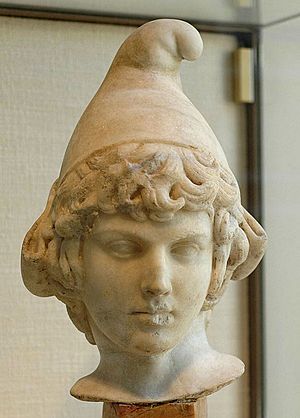Phrygian cap facts for kids

The Phrygian cap is a soft, cone-shaped hat with its tip bent forward. People in ancient times believed it was worn by various groups in Eastern Europe and Anatolia. These groups included people from Phrygia, Dacia, and the Balkans.
Later, during the French Revolution, this cap became a strong symbol of freedom. However, the Phrygian cap did not originally mean freedom. The first "cap of liberty" was actually the Roman pileus. This was a felt cap given to slaves when they became free in ancient Rome. It was also linked to Libertas, the Roman goddess of liberty.
In the 16th century, symbols of Roman liberty, like the pileus, started appearing again in books and coin guides. The goddess Libertas was often shown wearing a pileus. The idea of a cap as a symbol of freedom first became popular in the Netherlands. There, a cap of that time was used to represent liberty.
By the 18th century, the traditional liberty cap was often seen in English pictures. After 1789, it also appeared in French pictures. But it was not until the early 1790s that the French cap of liberty most often looked like the Phrygian cap.
Symbol of Freedom and Republics
The Phrygian cap is used in the official symbols of some countries that are republics. A republic is a country where the people, or their elected representatives, hold the power. In these symbols, the cap takes the place of a crown, which is used in countries ruled by a king or queen. This is how the Phrygian cap became known as a symbol of a republican government.
Many national figures, especially Marianne from France, are shown wearing the Phrygian cap. She is a symbol of the French Republic.
| 20 centime with Marianne on obverse | |
|---|---|
 |
|
| Obverse: Marianne wearing the Phrygian cap of liberty. | Reverse: Face value and French motto: "Liberté, égalité, fraternité". |
| This coin was minted from 1962 to 2001. | |
Images for kids
-
A prisoner wearing a Phrygian cap (Roman statue from the 2nd century), found at the Louvre.
-
Phrygian soldiers. This is a detail from a reconstructed building in Pararli, Turkey, from the 7th–6th centuries BC.
-
A Roman statue of Attis, who was linked to the Phrygian goddess Cybele. He is wearing a Phrygian cap and doing a special dance.
-
In this 1793 drawing by James Gillray, a Phrygian cap sits on a dangerous "Rock of Democracy." Britannia's boat, called the Constitution, sails between this rock and a "Whirlpool of Arbitrary-Power."
-
The 1783 Libertas Americana medal, created by Benjamin Franklin. It celebrates the American Revolution and shows the goddess of Liberty holding a Phrygian cap.
-
Bendis, a Thracian goddess of the moon and hunting. She is wearing a Phrygian cap. This is a small clay figure from around 350 BC.
-
A ceramic pot from ancient Magna Graecia (Italy). It shows a winged youth with blond hair and a Phrygian cap. Made around 300 BC.
-
Paris of Troy wearing a Phrygian cap. This is a Roman marble artwork from 117–138 CE.
-
The "three wise men" with Phrygian caps. These caps helped show they were from the "East." From the 6th century, in Ravenna, Italy.
See also
 In Spanish: Gorro frigio para niños
In Spanish: Gorro frigio para niños












